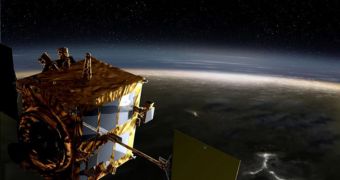Space analysts in Japan believe that the nation's space agency may need to rethink its long-term space strategy and ambitions, following last week's failure to put a spacecraft in Venusian orbit.
This is the second of two probes to miss its target, after the spacecraft Nozomi swung past Mars in 2003, failing to get captured in a stable orbit. That mission is currently on a heliocentric orbit.
Last week, the Akatsuki space probe, the world's first weather satellite around another planet, failed to decelerate sufficiently to be captured in an orbit around Venus, and overshot the planet.
According to early calculations, it will take until late 2016 – early 2017 for another orbital insertion attempt to become possible. These poor results deserve proper scrutiny, experts now say.
Even Akatsuki mission scientists believe that the Japanese Aerospace Exploration Agency (JAXA) should take a close, hard look at its plans, and trim them according to its actual capabilities.
“Our score is zero wins, two losses. We have to be more conservative to plan our next planetary mission, so it will never fail in any aspect,” JAXA official Takehiko Satoh told Space on December 16.
The interview was taken at the 2010 annual fall meeting of the American Geophysical Union (AGU), which was held in San Francisco, California, between December 13-17.
On December 6, Akatsuki reached a point some 342 miles (550 kilometers) away from its target. Once there, it was supposed to fire its thrusters, get obscured by the planet for a few minutes, then resume communications and enter orbit.
But the 22-minute communications blackout turned into a 90-minute one, and once contact was established the JAXA mission control team could see that the spacecraft was speeding away from its intended target.
According to Satoh, JAXA experts still have no idea why the thrusters misfired. “The pressure decrease was the direct cause. But we don't know why the pressure shut down,” he said.
The expert added that the Akatsuki team is relatively optimistic about the second orbital insertion attempt. “Everybody thought Hayabusa was unrecoverable. We now share that never-give-up-spirit with the Hayabusa team,” he explained.
The Hayabusa sample-return flight spent years traveling to the asteroid Ikotawa, and then returning home. Nearly everything that could have failed on it did, yet the sample chamber was safely returned to Earth this June.
“With Mars exploration, so many scientists want a big lander or a big rover. If we had previous successes with planetary orbital insertions, we might say, OK, we'll try something big,” Satoh said.
“But now, maybe we can do an orbiter and a very small lander or a small rover,” he added, saying that JAXA could learn a lot from NASA and the European Space Agency.

 14 DAY TRIAL //
14 DAY TRIAL //